Marketing Management Report: Woolworths Case Study Analysis
VerifiedAdded on 2021/05/31
|22
|4877
|46
Report
AI Summary
This report provides a comprehensive analysis of Woolworths' marketing management. It begins with an overview of the company's background, including its business policies and industry context. The report then delves into the 5Cs analysis, highlighting Woolworths' strengths such as its premium product quality and large customer base, while also identifying weaknesses like domestic growth limitations and competition. A detailed SWOT analysis is presented, along with an examination of consumer behavior theories, Porter's Five Forces, and PESTLE analysis to assess the external environment. Furthermore, the report explores the BCG matrix for Woolworths' marketing environment and concludes with actionable recommendations, including marketing mix strategies and a gap analysis to improve market penetration and address challenges within the Australian retail sector. The report is a Masters-level marketing assignment.
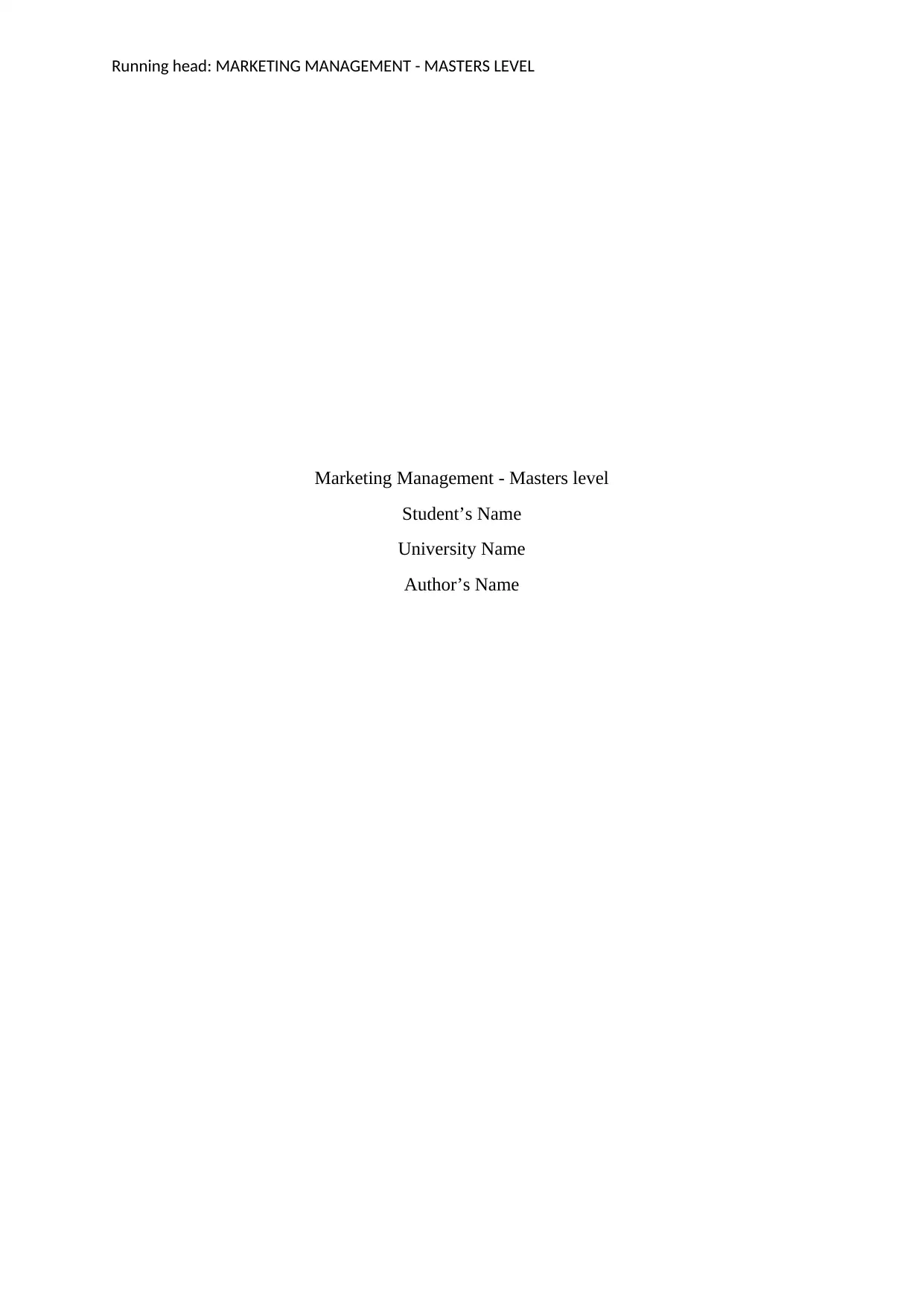
Running head: MARKETING MANAGEMENT - MASTERS LEVEL
Marketing Management - Masters level
Student’s Name
University Name
Author’s Name
Marketing Management - Masters level
Student’s Name
University Name
Author’s Name
Paraphrase This Document
Need a fresh take? Get an instant paraphrase of this document with our AI Paraphraser
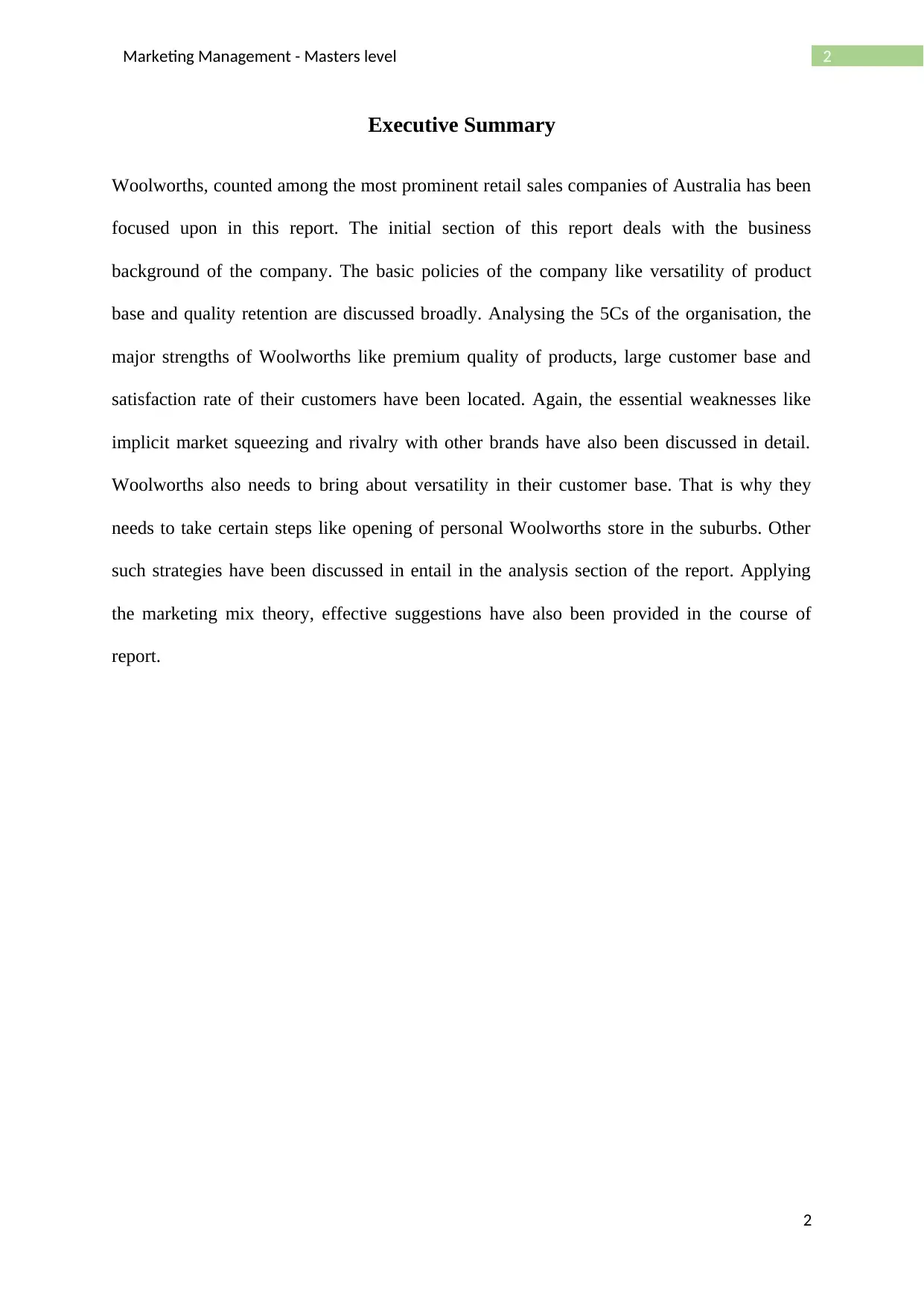
2Marketing Management - Masters level
Executive Summary
Woolworths, counted among the most prominent retail sales companies of Australia has been
focused upon in this report. The initial section of this report deals with the business
background of the company. The basic policies of the company like versatility of product
base and quality retention are discussed broadly. Analysing the 5Cs of the organisation, the
major strengths of Woolworths like premium quality of products, large customer base and
satisfaction rate of their customers have been located. Again, the essential weaknesses like
implicit market squeezing and rivalry with other brands have also been discussed in detail.
Woolworths also needs to bring about versatility in their customer base. That is why they
needs to take certain steps like opening of personal Woolworths store in the suburbs. Other
such strategies have been discussed in entail in the analysis section of the report. Applying
the marketing mix theory, effective suggestions have also been provided in the course of
report.
2
Executive Summary
Woolworths, counted among the most prominent retail sales companies of Australia has been
focused upon in this report. The initial section of this report deals with the business
background of the company. The basic policies of the company like versatility of product
base and quality retention are discussed broadly. Analysing the 5Cs of the organisation, the
major strengths of Woolworths like premium quality of products, large customer base and
satisfaction rate of their customers have been located. Again, the essential weaknesses like
implicit market squeezing and rivalry with other brands have also been discussed in detail.
Woolworths also needs to bring about versatility in their customer base. That is why they
needs to take certain steps like opening of personal Woolworths store in the suburbs. Other
such strategies have been discussed in entail in the analysis section of the report. Applying
the marketing mix theory, effective suggestions have also been provided in the course of
report.
2
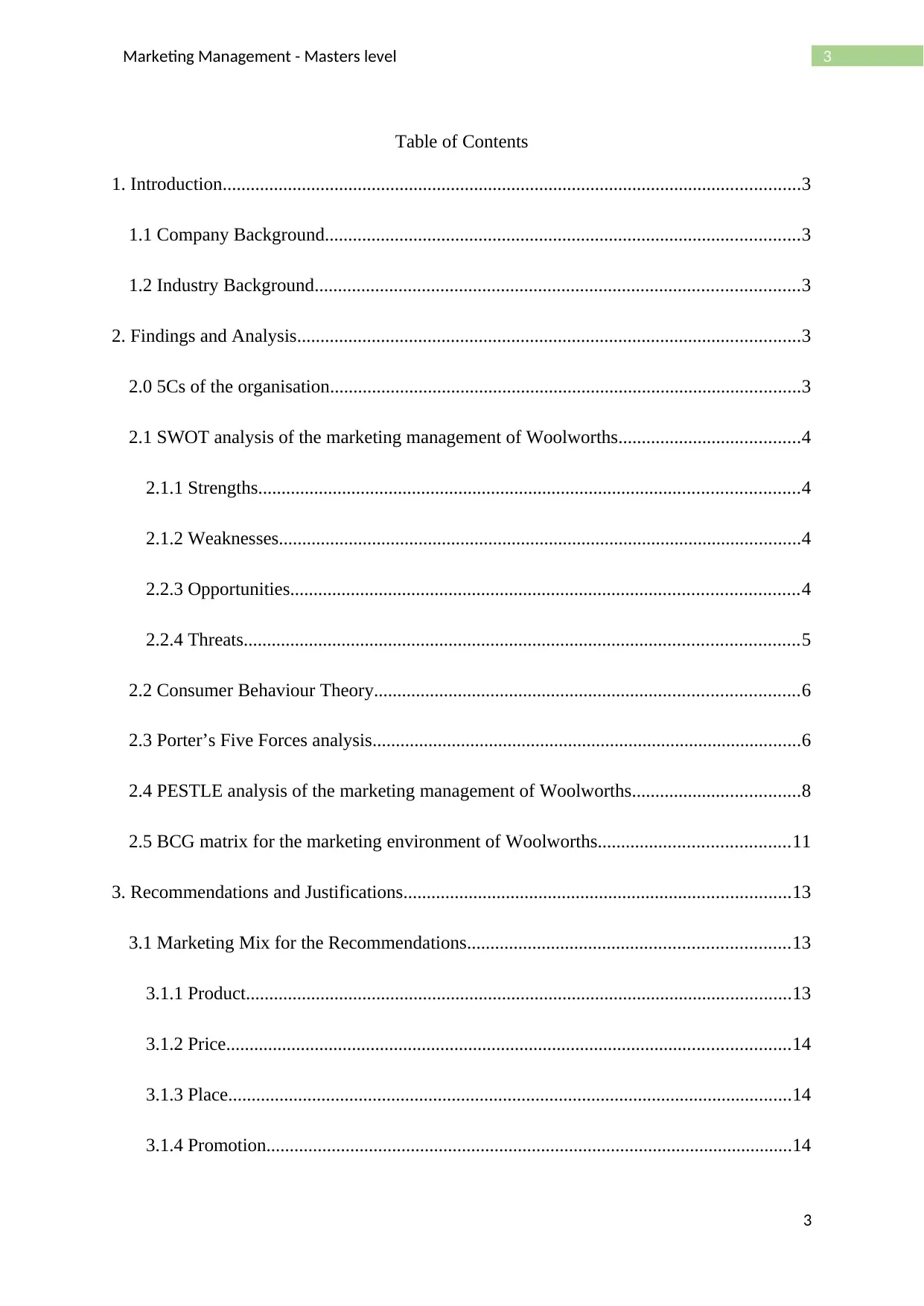
3Marketing Management - Masters level
Table of Contents
1. Introduction............................................................................................................................3
1.1 Company Background......................................................................................................3
1.2 Industry Background........................................................................................................3
2. Findings and Analysis............................................................................................................3
2.0 5Cs of the organisation.....................................................................................................3
2.1 SWOT analysis of the marketing management of Woolworths.......................................4
2.1.1 Strengths....................................................................................................................4
2.1.2 Weaknesses................................................................................................................4
2.2.3 Opportunities.............................................................................................................4
2.2.4 Threats.......................................................................................................................5
2.2 Consumer Behaviour Theory...........................................................................................6
2.3 Porter’s Five Forces analysis............................................................................................6
2.4 PESTLE analysis of the marketing management of Woolworths....................................8
2.5 BCG matrix for the marketing environment of Woolworths.........................................11
3. Recommendations and Justifications...................................................................................13
3.1 Marketing Mix for the Recommendations.....................................................................13
3.1.1 Product.....................................................................................................................13
3.1.2 Price.........................................................................................................................14
3.1.3 Place.........................................................................................................................14
3.1.4 Promotion.................................................................................................................14
3
Table of Contents
1. Introduction............................................................................................................................3
1.1 Company Background......................................................................................................3
1.2 Industry Background........................................................................................................3
2. Findings and Analysis............................................................................................................3
2.0 5Cs of the organisation.....................................................................................................3
2.1 SWOT analysis of the marketing management of Woolworths.......................................4
2.1.1 Strengths....................................................................................................................4
2.1.2 Weaknesses................................................................................................................4
2.2.3 Opportunities.............................................................................................................4
2.2.4 Threats.......................................................................................................................5
2.2 Consumer Behaviour Theory...........................................................................................6
2.3 Porter’s Five Forces analysis............................................................................................6
2.4 PESTLE analysis of the marketing management of Woolworths....................................8
2.5 BCG matrix for the marketing environment of Woolworths.........................................11
3. Recommendations and Justifications...................................................................................13
3.1 Marketing Mix for the Recommendations.....................................................................13
3.1.1 Product.....................................................................................................................13
3.1.2 Price.........................................................................................................................14
3.1.3 Place.........................................................................................................................14
3.1.4 Promotion.................................................................................................................14
3
⊘ This is a preview!⊘
Do you want full access?
Subscribe today to unlock all pages.

Trusted by 1+ million students worldwide
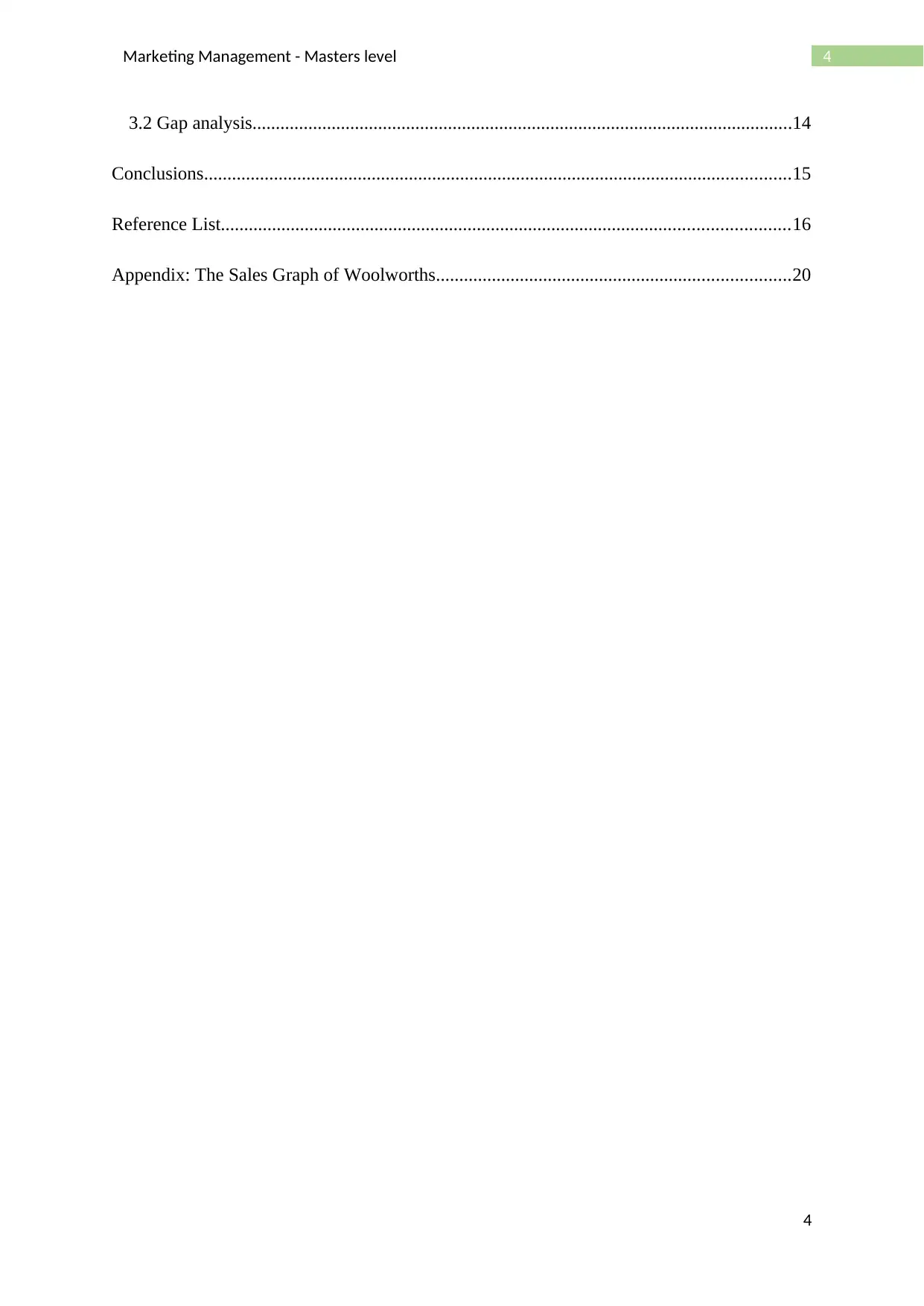
4Marketing Management - Masters level
3.2 Gap analysis....................................................................................................................14
Conclusions..............................................................................................................................15
Reference List..........................................................................................................................16
Appendix: The Sales Graph of Woolworths............................................................................20
4
3.2 Gap analysis....................................................................................................................14
Conclusions..............................................................................................................................15
Reference List..........................................................................................................................16
Appendix: The Sales Graph of Woolworths............................................................................20
4
Paraphrase This Document
Need a fresh take? Get an instant paraphrase of this document with our AI Paraphraser
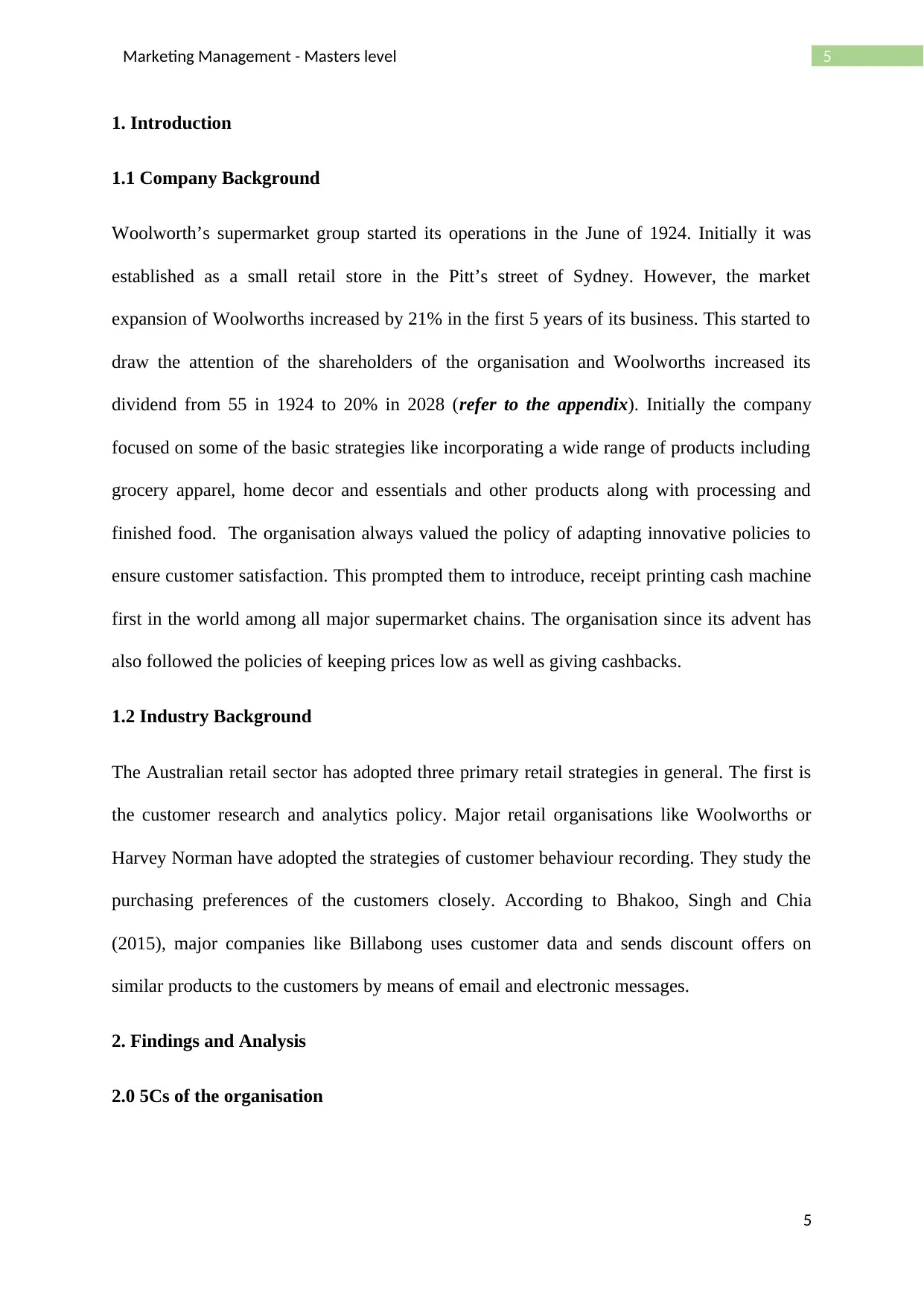
5Marketing Management - Masters level
1. Introduction
1.1 Company Background
Woolworth’s supermarket group started its operations in the June of 1924. Initially it was
established as a small retail store in the Pitt’s street of Sydney. However, the market
expansion of Woolworths increased by 21% in the first 5 years of its business. This started to
draw the attention of the shareholders of the organisation and Woolworths increased its
dividend from 55 in 1924 to 20% in 2028 (refer to the appendix). Initially the company
focused on some of the basic strategies like incorporating a wide range of products including
grocery apparel, home decor and essentials and other products along with processing and
finished food. The organisation always valued the policy of adapting innovative policies to
ensure customer satisfaction. This prompted them to introduce, receipt printing cash machine
first in the world among all major supermarket chains. The organisation since its advent has
also followed the policies of keeping prices low as well as giving cashbacks.
1.2 Industry Background
The Australian retail sector has adopted three primary retail strategies in general. The first is
the customer research and analytics policy. Major retail organisations like Woolworths or
Harvey Norman have adopted the strategies of customer behaviour recording. They study the
purchasing preferences of the customers closely. According to Bhakoo, Singh and Chia
(2015), major companies like Billabong uses customer data and sends discount offers on
similar products to the customers by means of email and electronic messages.
2. Findings and Analysis
2.0 5Cs of the organisation
5
1. Introduction
1.1 Company Background
Woolworth’s supermarket group started its operations in the June of 1924. Initially it was
established as a small retail store in the Pitt’s street of Sydney. However, the market
expansion of Woolworths increased by 21% in the first 5 years of its business. This started to
draw the attention of the shareholders of the organisation and Woolworths increased its
dividend from 55 in 1924 to 20% in 2028 (refer to the appendix). Initially the company
focused on some of the basic strategies like incorporating a wide range of products including
grocery apparel, home decor and essentials and other products along with processing and
finished food. The organisation always valued the policy of adapting innovative policies to
ensure customer satisfaction. This prompted them to introduce, receipt printing cash machine
first in the world among all major supermarket chains. The organisation since its advent has
also followed the policies of keeping prices low as well as giving cashbacks.
1.2 Industry Background
The Australian retail sector has adopted three primary retail strategies in general. The first is
the customer research and analytics policy. Major retail organisations like Woolworths or
Harvey Norman have adopted the strategies of customer behaviour recording. They study the
purchasing preferences of the customers closely. According to Bhakoo, Singh and Chia
(2015), major companies like Billabong uses customer data and sends discount offers on
similar products to the customers by means of email and electronic messages.
2. Findings and Analysis
2.0 5Cs of the organisation
5
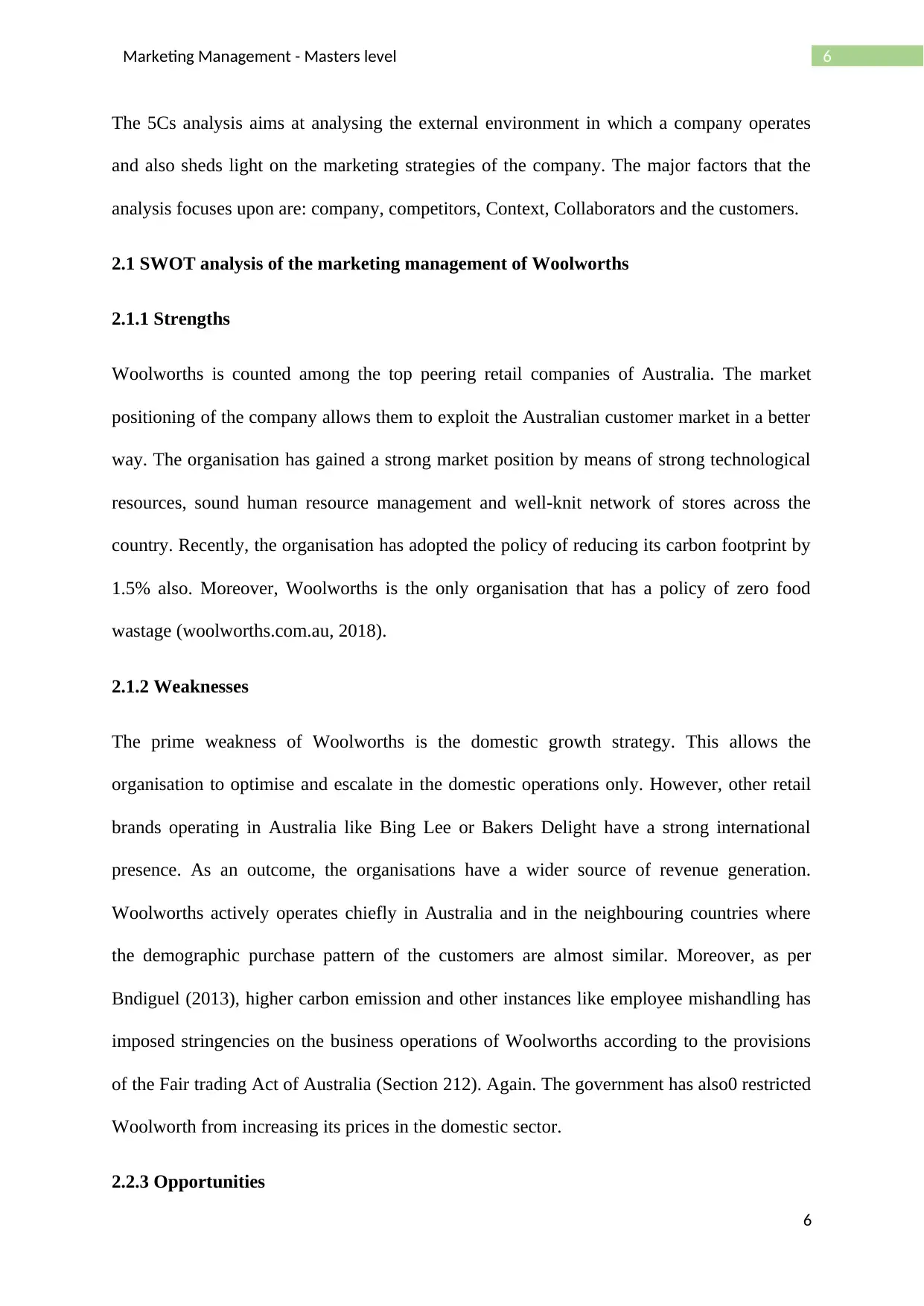
6Marketing Management - Masters level
The 5Cs analysis aims at analysing the external environment in which a company operates
and also sheds light on the marketing strategies of the company. The major factors that the
analysis focuses upon are: company, competitors, Context, Collaborators and the customers.
2.1 SWOT analysis of the marketing management of Woolworths
2.1.1 Strengths
Woolworths is counted among the top peering retail companies of Australia. The market
positioning of the company allows them to exploit the Australian customer market in a better
way. The organisation has gained a strong market position by means of strong technological
resources, sound human resource management and well-knit network of stores across the
country. Recently, the organisation has adopted the policy of reducing its carbon footprint by
1.5% also. Moreover, Woolworths is the only organisation that has a policy of zero food
wastage (woolworths.com.au, 2018).
2.1.2 Weaknesses
The prime weakness of Woolworths is the domestic growth strategy. This allows the
organisation to optimise and escalate in the domestic operations only. However, other retail
brands operating in Australia like Bing Lee or Bakers Delight have a strong international
presence. As an outcome, the organisations have a wider source of revenue generation.
Woolworths actively operates chiefly in Australia and in the neighbouring countries where
the demographic purchase pattern of the customers are almost similar. Moreover, as per
Bndiguel (2013), higher carbon emission and other instances like employee mishandling has
imposed stringencies on the business operations of Woolworths according to the provisions
of the Fair trading Act of Australia (Section 212). Again. The government has also0 restricted
Woolworth from increasing its prices in the domestic sector.
2.2.3 Opportunities
6
The 5Cs analysis aims at analysing the external environment in which a company operates
and also sheds light on the marketing strategies of the company. The major factors that the
analysis focuses upon are: company, competitors, Context, Collaborators and the customers.
2.1 SWOT analysis of the marketing management of Woolworths
2.1.1 Strengths
Woolworths is counted among the top peering retail companies of Australia. The market
positioning of the company allows them to exploit the Australian customer market in a better
way. The organisation has gained a strong market position by means of strong technological
resources, sound human resource management and well-knit network of stores across the
country. Recently, the organisation has adopted the policy of reducing its carbon footprint by
1.5% also. Moreover, Woolworths is the only organisation that has a policy of zero food
wastage (woolworths.com.au, 2018).
2.1.2 Weaknesses
The prime weakness of Woolworths is the domestic growth strategy. This allows the
organisation to optimise and escalate in the domestic operations only. However, other retail
brands operating in Australia like Bing Lee or Bakers Delight have a strong international
presence. As an outcome, the organisations have a wider source of revenue generation.
Woolworths actively operates chiefly in Australia and in the neighbouring countries where
the demographic purchase pattern of the customers are almost similar. Moreover, as per
Bndiguel (2013), higher carbon emission and other instances like employee mishandling has
imposed stringencies on the business operations of Woolworths according to the provisions
of the Fair trading Act of Australia (Section 212). Again. The government has also0 restricted
Woolworth from increasing its prices in the domestic sector.
2.2.3 Opportunities
6
⊘ This is a preview!⊘
Do you want full access?
Subscribe today to unlock all pages.

Trusted by 1+ million students worldwide
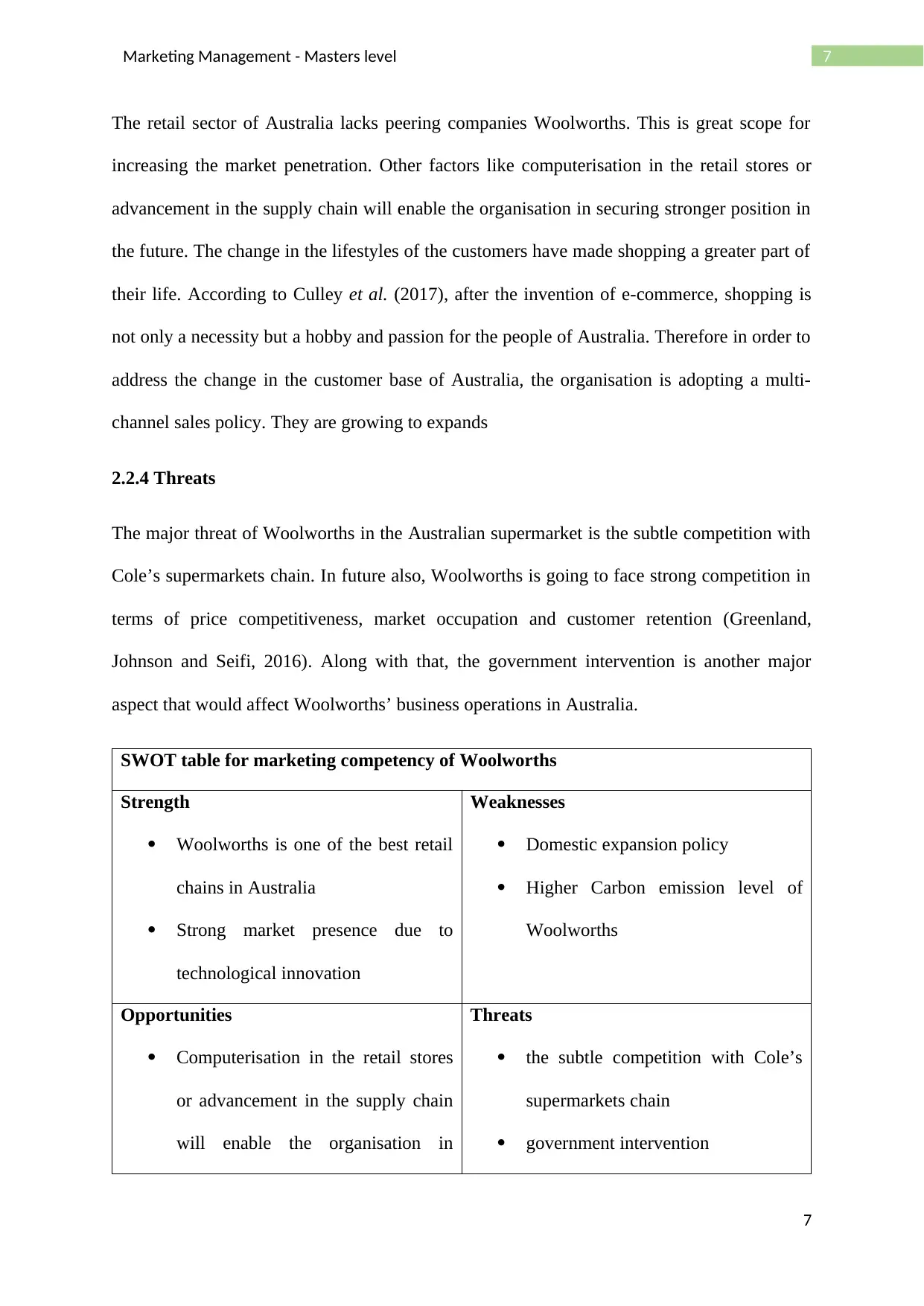
7Marketing Management - Masters level
The retail sector of Australia lacks peering companies Woolworths. This is great scope for
increasing the market penetration. Other factors like computerisation in the retail stores or
advancement in the supply chain will enable the organisation in securing stronger position in
the future. The change in the lifestyles of the customers have made shopping a greater part of
their life. According to Culley et al. (2017), after the invention of e-commerce, shopping is
not only a necessity but a hobby and passion for the people of Australia. Therefore in order to
address the change in the customer base of Australia, the organisation is adopting a multi-
channel sales policy. They are growing to expands
2.2.4 Threats
The major threat of Woolworths in the Australian supermarket is the subtle competition with
Cole’s supermarkets chain. In future also, Woolworths is going to face strong competition in
terms of price competitiveness, market occupation and customer retention (Greenland,
Johnson and Seifi, 2016). Along with that, the government intervention is another major
aspect that would affect Woolworths’ business operations in Australia.
SWOT table for marketing competency of Woolworths
Strength
Woolworths is one of the best retail
chains in Australia
Strong market presence due to
technological innovation
Weaknesses
Domestic expansion policy
Higher Carbon emission level of
Woolworths
Opportunities
Computerisation in the retail stores
or advancement in the supply chain
will enable the organisation in
Threats
the subtle competition with Cole’s
supermarkets chain
government intervention
7
The retail sector of Australia lacks peering companies Woolworths. This is great scope for
increasing the market penetration. Other factors like computerisation in the retail stores or
advancement in the supply chain will enable the organisation in securing stronger position in
the future. The change in the lifestyles of the customers have made shopping a greater part of
their life. According to Culley et al. (2017), after the invention of e-commerce, shopping is
not only a necessity but a hobby and passion for the people of Australia. Therefore in order to
address the change in the customer base of Australia, the organisation is adopting a multi-
channel sales policy. They are growing to expands
2.2.4 Threats
The major threat of Woolworths in the Australian supermarket is the subtle competition with
Cole’s supermarkets chain. In future also, Woolworths is going to face strong competition in
terms of price competitiveness, market occupation and customer retention (Greenland,
Johnson and Seifi, 2016). Along with that, the government intervention is another major
aspect that would affect Woolworths’ business operations in Australia.
SWOT table for marketing competency of Woolworths
Strength
Woolworths is one of the best retail
chains in Australia
Strong market presence due to
technological innovation
Weaknesses
Domestic expansion policy
Higher Carbon emission level of
Woolworths
Opportunities
Computerisation in the retail stores
or advancement in the supply chain
will enable the organisation in
Threats
the subtle competition with Cole’s
supermarkets chain
government intervention
7
Paraphrase This Document
Need a fresh take? Get an instant paraphrase of this document with our AI Paraphraser
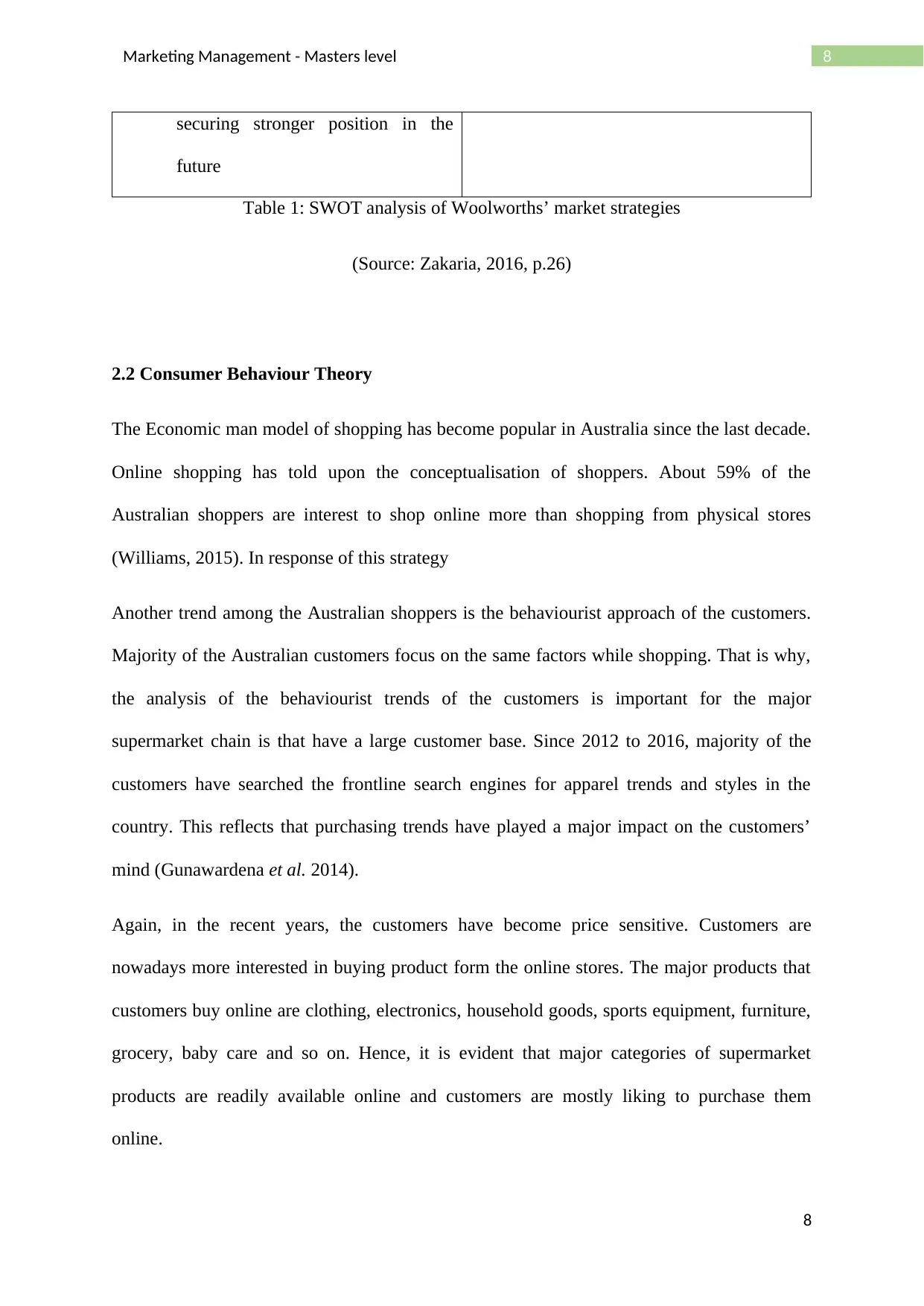
8Marketing Management - Masters level
securing stronger position in the
future
Table 1: SWOT analysis of Woolworths’ market strategies
(Source: Zakaria, 2016, p.26)
2.2 Consumer Behaviour Theory
The Economic man model of shopping has become popular in Australia since the last decade.
Online shopping has told upon the conceptualisation of shoppers. About 59% of the
Australian shoppers are interest to shop online more than shopping from physical stores
(Williams, 2015). In response of this strategy
Another trend among the Australian shoppers is the behaviourist approach of the customers.
Majority of the Australian customers focus on the same factors while shopping. That is why,
the analysis of the behaviourist trends of the customers is important for the major
supermarket chain is that have a large customer base. Since 2012 to 2016, majority of the
customers have searched the frontline search engines for apparel trends and styles in the
country. This reflects that purchasing trends have played a major impact on the customers’
mind (Gunawardena et al. 2014).
Again, in the recent years, the customers have become price sensitive. Customers are
nowadays more interested in buying product form the online stores. The major products that
customers buy online are clothing, electronics, household goods, sports equipment, furniture,
grocery, baby care and so on. Hence, it is evident that major categories of supermarket
products are readily available online and customers are mostly liking to purchase them
online.
8
securing stronger position in the
future
Table 1: SWOT analysis of Woolworths’ market strategies
(Source: Zakaria, 2016, p.26)
2.2 Consumer Behaviour Theory
The Economic man model of shopping has become popular in Australia since the last decade.
Online shopping has told upon the conceptualisation of shoppers. About 59% of the
Australian shoppers are interest to shop online more than shopping from physical stores
(Williams, 2015). In response of this strategy
Another trend among the Australian shoppers is the behaviourist approach of the customers.
Majority of the Australian customers focus on the same factors while shopping. That is why,
the analysis of the behaviourist trends of the customers is important for the major
supermarket chain is that have a large customer base. Since 2012 to 2016, majority of the
customers have searched the frontline search engines for apparel trends and styles in the
country. This reflects that purchasing trends have played a major impact on the customers’
mind (Gunawardena et al. 2014).
Again, in the recent years, the customers have become price sensitive. Customers are
nowadays more interested in buying product form the online stores. The major products that
customers buy online are clothing, electronics, household goods, sports equipment, furniture,
grocery, baby care and so on. Hence, it is evident that major categories of supermarket
products are readily available online and customers are mostly liking to purchase them
online.
8
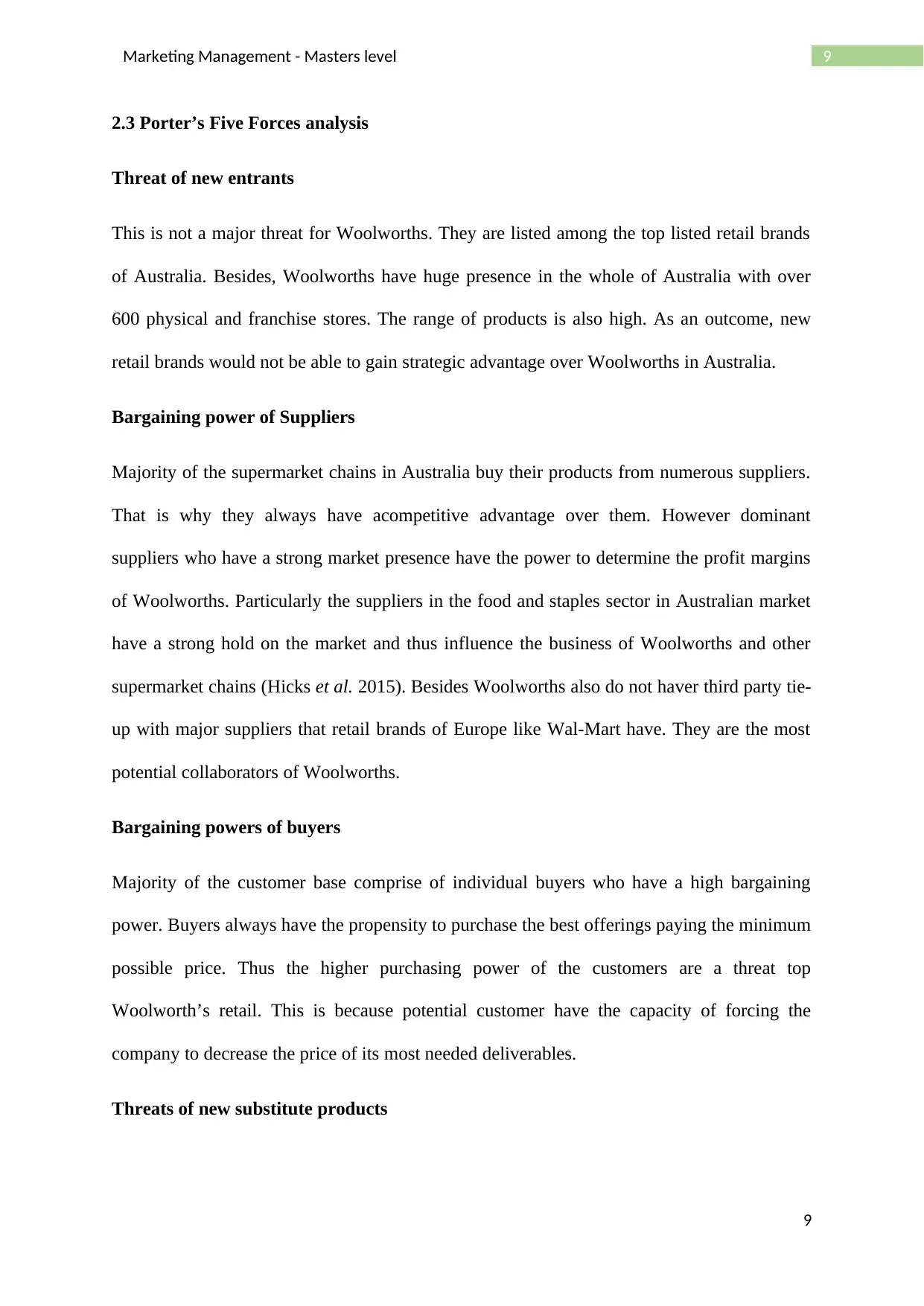
9Marketing Management - Masters level
2.3 Porter’s Five Forces analysis
Threat of new entrants
This is not a major threat for Woolworths. They are listed among the top listed retail brands
of Australia. Besides, Woolworths have huge presence in the whole of Australia with over
600 physical and franchise stores. The range of products is also high. As an outcome, new
retail brands would not be able to gain strategic advantage over Woolworths in Australia.
Bargaining power of Suppliers
Majority of the supermarket chains in Australia buy their products from numerous suppliers.
That is why they always have acompetitive advantage over them. However dominant
suppliers who have a strong market presence have the power to determine the profit margins
of Woolworths. Particularly the suppliers in the food and staples sector in Australian market
have a strong hold on the market and thus influence the business of Woolworths and other
supermarket chains (Hicks et al. 2015). Besides Woolworths also do not haver third party tie-
up with major suppliers that retail brands of Europe like Wal-Mart have. They are the most
potential collaborators of Woolworths.
Bargaining powers of buyers
Majority of the customer base comprise of individual buyers who have a high bargaining
power. Buyers always have the propensity to purchase the best offerings paying the minimum
possible price. Thus the higher purchasing power of the customers are a threat top
Woolworth’s retail. This is because potential customer have the capacity of forcing the
company to decrease the price of its most needed deliverables.
Threats of new substitute products
9
2.3 Porter’s Five Forces analysis
Threat of new entrants
This is not a major threat for Woolworths. They are listed among the top listed retail brands
of Australia. Besides, Woolworths have huge presence in the whole of Australia with over
600 physical and franchise stores. The range of products is also high. As an outcome, new
retail brands would not be able to gain strategic advantage over Woolworths in Australia.
Bargaining power of Suppliers
Majority of the supermarket chains in Australia buy their products from numerous suppliers.
That is why they always have acompetitive advantage over them. However dominant
suppliers who have a strong market presence have the power to determine the profit margins
of Woolworths. Particularly the suppliers in the food and staples sector in Australian market
have a strong hold on the market and thus influence the business of Woolworths and other
supermarket chains (Hicks et al. 2015). Besides Woolworths also do not haver third party tie-
up with major suppliers that retail brands of Europe like Wal-Mart have. They are the most
potential collaborators of Woolworths.
Bargaining powers of buyers
Majority of the customer base comprise of individual buyers who have a high bargaining
power. Buyers always have the propensity to purchase the best offerings paying the minimum
possible price. Thus the higher purchasing power of the customers are a threat top
Woolworth’s retail. This is because potential customer have the capacity of forcing the
company to decrease the price of its most needed deliverables.
Threats of new substitute products
9
⊘ This is a preview!⊘
Do you want full access?
Subscribe today to unlock all pages.

Trusted by 1+ million students worldwide
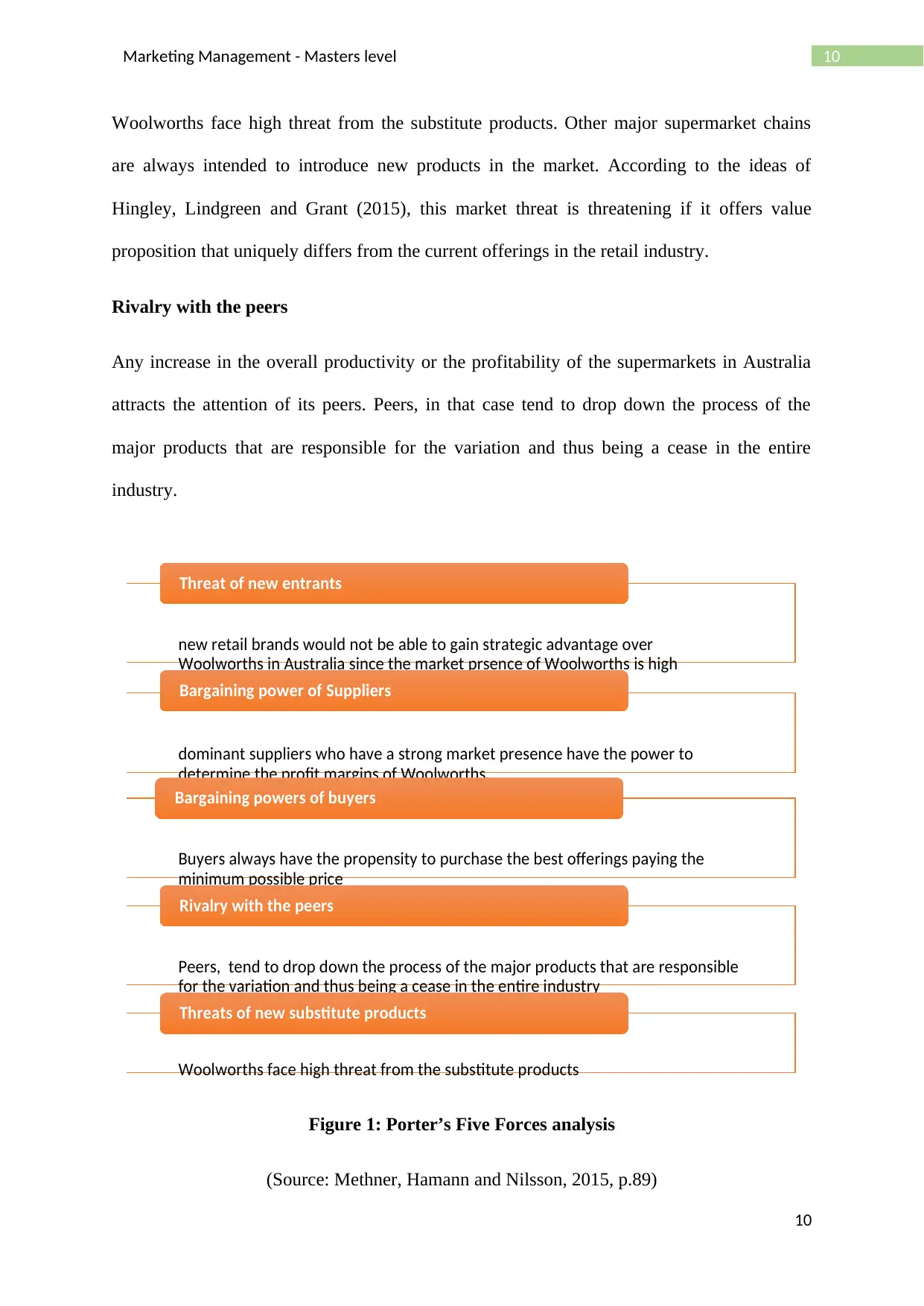
10Marketing Management - Masters level
Woolworths face high threat from the substitute products. Other major supermarket chains
are always intended to introduce new products in the market. According to the ideas of
Hingley, Lindgreen and Grant (2015), this market threat is threatening if it offers value
proposition that uniquely differs from the current offerings in the retail industry.
Rivalry with the peers
Any increase in the overall productivity or the profitability of the supermarkets in Australia
attracts the attention of its peers. Peers, in that case tend to drop down the process of the
major products that are responsible for the variation and thus being a cease in the entire
industry.
Figure 1: Porter’s Five Forces analysis
(Source: Methner, Hamann and Nilsson, 2015, p.89)
10
new retail brands would not be able to gain strategic advantage over
Woolworths in Australia since the market prsence of Woolworths is high
Threat of new entrants
dominant suppliers who have a strong market presence have the power to
determine the profit margins of Woolworths.
Bargaining power of Suppliers
Buyers always have the propensity to purchase the best offerings paying the
minimum possible price
Bargaining powers of buyers
Peers, tend to drop down the process of the major products that are responsible
for the variation and thus being a cease in the entire industry
Rivalry with the peers
Woolworths face high threat from the substitute products
Threats of new substitute products
Woolworths face high threat from the substitute products. Other major supermarket chains
are always intended to introduce new products in the market. According to the ideas of
Hingley, Lindgreen and Grant (2015), this market threat is threatening if it offers value
proposition that uniquely differs from the current offerings in the retail industry.
Rivalry with the peers
Any increase in the overall productivity or the profitability of the supermarkets in Australia
attracts the attention of its peers. Peers, in that case tend to drop down the process of the
major products that are responsible for the variation and thus being a cease in the entire
industry.
Figure 1: Porter’s Five Forces analysis
(Source: Methner, Hamann and Nilsson, 2015, p.89)
10
new retail brands would not be able to gain strategic advantage over
Woolworths in Australia since the market prsence of Woolworths is high
Threat of new entrants
dominant suppliers who have a strong market presence have the power to
determine the profit margins of Woolworths.
Bargaining power of Suppliers
Buyers always have the propensity to purchase the best offerings paying the
minimum possible price
Bargaining powers of buyers
Peers, tend to drop down the process of the major products that are responsible
for the variation and thus being a cease in the entire industry
Rivalry with the peers
Woolworths face high threat from the substitute products
Threats of new substitute products
Paraphrase This Document
Need a fresh take? Get an instant paraphrase of this document with our AI Paraphraser
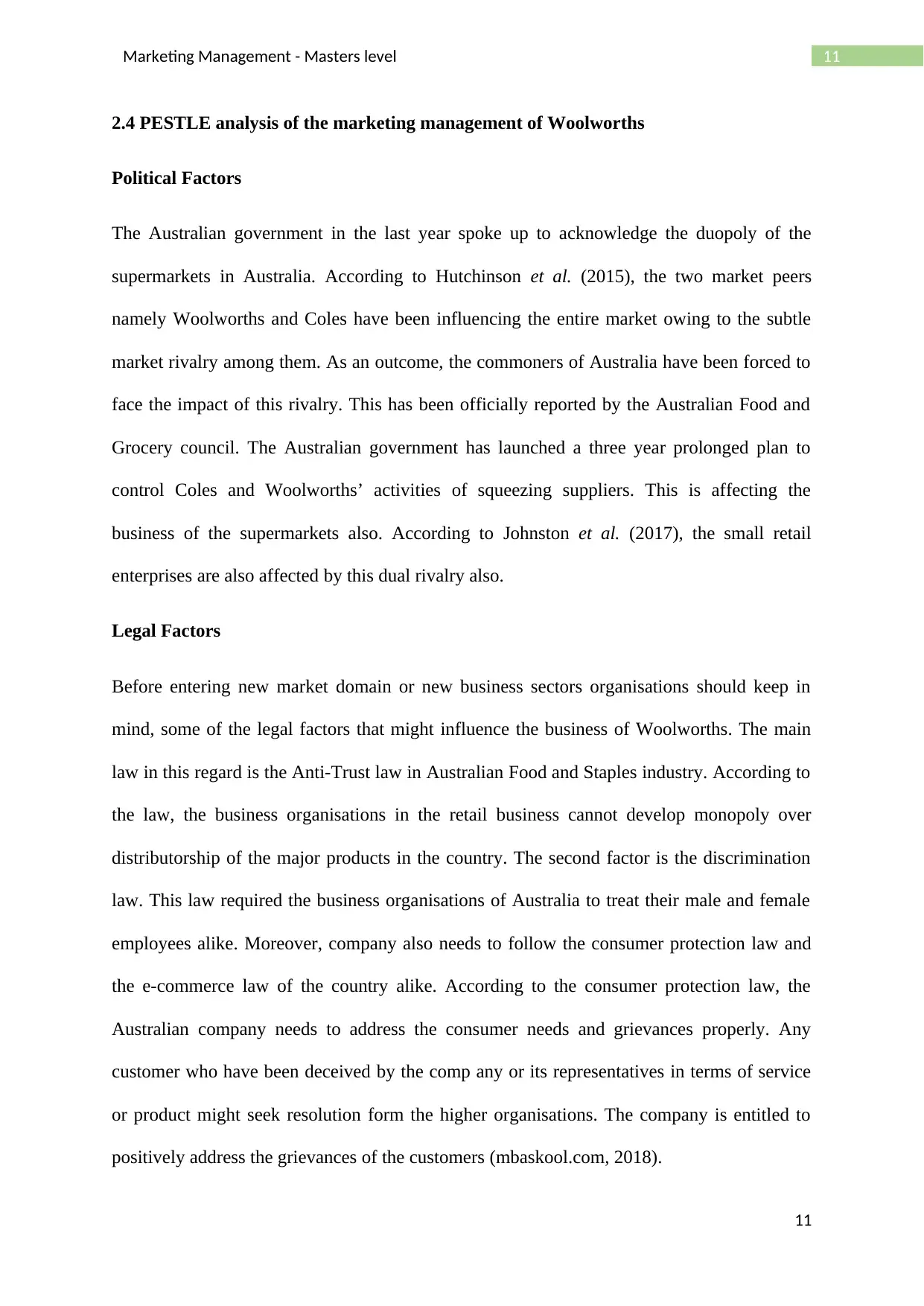
11Marketing Management - Masters level
2.4 PESTLE analysis of the marketing management of Woolworths
Political Factors
The Australian government in the last year spoke up to acknowledge the duopoly of the
supermarkets in Australia. According to Hutchinson et al. (2015), the two market peers
namely Woolworths and Coles have been influencing the entire market owing to the subtle
market rivalry among them. As an outcome, the commoners of Australia have been forced to
face the impact of this rivalry. This has been officially reported by the Australian Food and
Grocery council. The Australian government has launched a three year prolonged plan to
control Coles and Woolworths’ activities of squeezing suppliers. This is affecting the
business of the supermarkets also. According to Johnston et al. (2017), the small retail
enterprises are also affected by this dual rivalry also.
Legal Factors
Before entering new market domain or new business sectors organisations should keep in
mind, some of the legal factors that might influence the business of Woolworths. The main
law in this regard is the Anti-Trust law in Australian Food and Staples industry. According to
the law, the business organisations in the retail business cannot develop monopoly over
distributorship of the major products in the country. The second factor is the discrimination
law. This law required the business organisations of Australia to treat their male and female
employees alike. Moreover, company also needs to follow the consumer protection law and
the e-commerce law of the country alike. According to the consumer protection law, the
Australian company needs to address the consumer needs and grievances properly. Any
customer who have been deceived by the comp any or its representatives in terms of service
or product might seek resolution form the higher organisations. The company is entitled to
positively address the grievances of the customers (mbaskool.com, 2018).
11
2.4 PESTLE analysis of the marketing management of Woolworths
Political Factors
The Australian government in the last year spoke up to acknowledge the duopoly of the
supermarkets in Australia. According to Hutchinson et al. (2015), the two market peers
namely Woolworths and Coles have been influencing the entire market owing to the subtle
market rivalry among them. As an outcome, the commoners of Australia have been forced to
face the impact of this rivalry. This has been officially reported by the Australian Food and
Grocery council. The Australian government has launched a three year prolonged plan to
control Coles and Woolworths’ activities of squeezing suppliers. This is affecting the
business of the supermarkets also. According to Johnston et al. (2017), the small retail
enterprises are also affected by this dual rivalry also.
Legal Factors
Before entering new market domain or new business sectors organisations should keep in
mind, some of the legal factors that might influence the business of Woolworths. The main
law in this regard is the Anti-Trust law in Australian Food and Staples industry. According to
the law, the business organisations in the retail business cannot develop monopoly over
distributorship of the major products in the country. The second factor is the discrimination
law. This law required the business organisations of Australia to treat their male and female
employees alike. Moreover, company also needs to follow the consumer protection law and
the e-commerce law of the country alike. According to the consumer protection law, the
Australian company needs to address the consumer needs and grievances properly. Any
customer who have been deceived by the comp any or its representatives in terms of service
or product might seek resolution form the higher organisations. The company is entitled to
positively address the grievances of the customers (mbaskool.com, 2018).
11
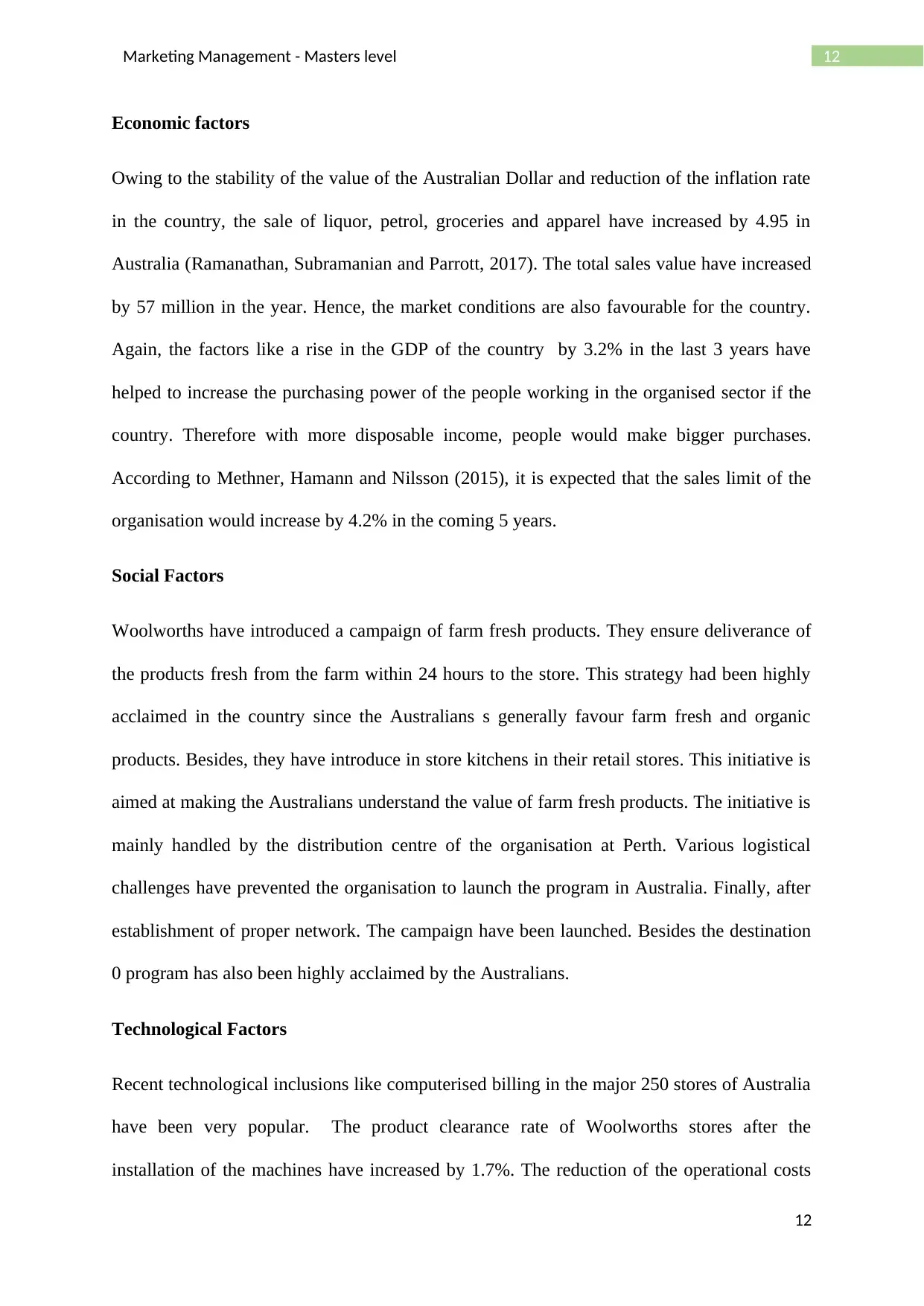
12Marketing Management - Masters level
Economic factors
Owing to the stability of the value of the Australian Dollar and reduction of the inflation rate
in the country, the sale of liquor, petrol, groceries and apparel have increased by 4.95 in
Australia (Ramanathan, Subramanian and Parrott, 2017). The total sales value have increased
by 57 million in the year. Hence, the market conditions are also favourable for the country.
Again, the factors like a rise in the GDP of the country by 3.2% in the last 3 years have
helped to increase the purchasing power of the people working in the organised sector if the
country. Therefore with more disposable income, people would make bigger purchases.
According to Methner, Hamann and Nilsson (2015), it is expected that the sales limit of the
organisation would increase by 4.2% in the coming 5 years.
Social Factors
Woolworths have introduced a campaign of farm fresh products. They ensure deliverance of
the products fresh from the farm within 24 hours to the store. This strategy had been highly
acclaimed in the country since the Australians s generally favour farm fresh and organic
products. Besides, they have introduce in store kitchens in their retail stores. This initiative is
aimed at making the Australians understand the value of farm fresh products. The initiative is
mainly handled by the distribution centre of the organisation at Perth. Various logistical
challenges have prevented the organisation to launch the program in Australia. Finally, after
establishment of proper network. The campaign have been launched. Besides the destination
0 program has also been highly acclaimed by the Australians.
Technological Factors
Recent technological inclusions like computerised billing in the major 250 stores of Australia
have been very popular. The product clearance rate of Woolworths stores after the
installation of the machines have increased by 1.7%. The reduction of the operational costs
12
Economic factors
Owing to the stability of the value of the Australian Dollar and reduction of the inflation rate
in the country, the sale of liquor, petrol, groceries and apparel have increased by 4.95 in
Australia (Ramanathan, Subramanian and Parrott, 2017). The total sales value have increased
by 57 million in the year. Hence, the market conditions are also favourable for the country.
Again, the factors like a rise in the GDP of the country by 3.2% in the last 3 years have
helped to increase the purchasing power of the people working in the organised sector if the
country. Therefore with more disposable income, people would make bigger purchases.
According to Methner, Hamann and Nilsson (2015), it is expected that the sales limit of the
organisation would increase by 4.2% in the coming 5 years.
Social Factors
Woolworths have introduced a campaign of farm fresh products. They ensure deliverance of
the products fresh from the farm within 24 hours to the store. This strategy had been highly
acclaimed in the country since the Australians s generally favour farm fresh and organic
products. Besides, they have introduce in store kitchens in their retail stores. This initiative is
aimed at making the Australians understand the value of farm fresh products. The initiative is
mainly handled by the distribution centre of the organisation at Perth. Various logistical
challenges have prevented the organisation to launch the program in Australia. Finally, after
establishment of proper network. The campaign have been launched. Besides the destination
0 program has also been highly acclaimed by the Australians.
Technological Factors
Recent technological inclusions like computerised billing in the major 250 stores of Australia
have been very popular. The product clearance rate of Woolworths stores after the
installation of the machines have increased by 1.7%. The reduction of the operational costs
12
⊘ This is a preview!⊘
Do you want full access?
Subscribe today to unlock all pages.

Trusted by 1+ million students worldwide
1 out of 22
Related Documents
Your All-in-One AI-Powered Toolkit for Academic Success.
+13062052269
info@desklib.com
Available 24*7 on WhatsApp / Email
![[object Object]](/_next/static/media/star-bottom.7253800d.svg)
Unlock your academic potential
Copyright © 2020–2025 A2Z Services. All Rights Reserved. Developed and managed by ZUCOL.



